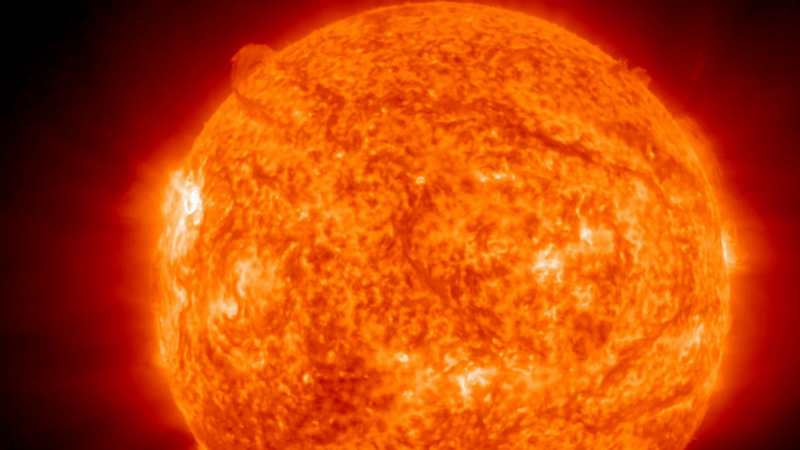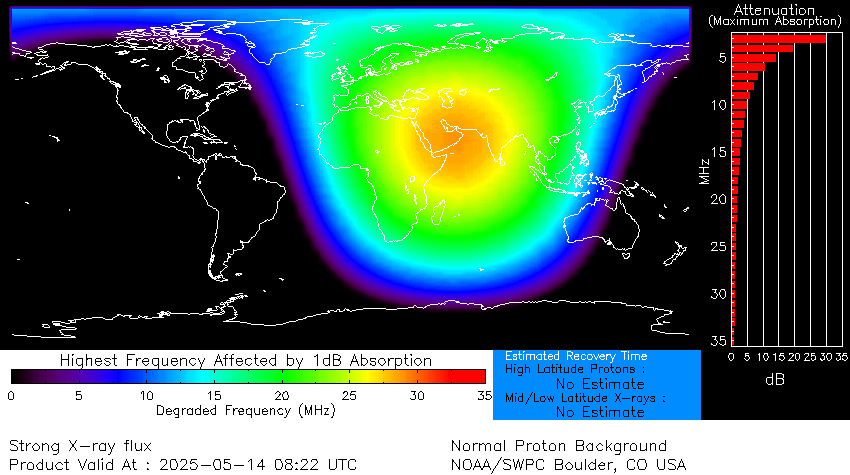Strongest solar flare of 2025 erupts from sun, sparking radio blackouts across Europe, Asia and the Middle East (video)
X2.7-class eruption from sunspot AR4087 disrupts radio signals as the active region rotates toward Earth, raising the risk of more flares ahead.
The sun roared to life early Tuesday (May 14), unleashing a powerful X-class solar flare from a newly emerging sunspot region AR4087.
The eruption peaked at 4:25 a.m. EDT (0825 GMT), triggering strong R3-level radio blackouts across Europe, Asia and the Middle East — the sunlit side of Earth at the time — as sunspot region 2087 crackles with activity.
Solar flares of this magnitude are uncommon, according to the NOAA Space Weather Prediction Center (SWPC). Solar flares are ranked by strength in five classes: A, B, C, M and X, with each step representing a tenfold increase in energy. The recent X flare clocked in at X2.7, placing it at the lower end of the most powerful solar flare class.

The eruption sent a blast of X-rays and extreme ultraviolet radiation hurling toward Earth at the speed of light, rapidly ionizing the upper atmosphere. This sudden change disrupted high-frequency radio signals, leading to communication dropouts for some radio operators across affected regions.
There may have been an associated coronal mass ejection (CME) — massive plumes of solar plasma and magnetic field accompanying the X-flare, though it is yet to be confirmed. CMEs can spark geomagnetic storms and vibrant auroras if they collide with Earth's magnetic field. But with AR4087 still near the sun's edge, our planet is out of the line of fire. For now.

That may change soon as AR4087 is rotating toward Earth and has already fired off multiple solar flares.
"This is getting intense, especially as this active region turns closer into view. This same AR just produced an M5.3 flare a few hours ago," aurora chaser Vincent Ledvina wrote in a post on X. "What does this AR have planned over the next days … we'll have to wait and see."
Breaking space news, the latest updates on rocket launches, skywatching events and more!
WOW, happening now: an X2.7 flare from AR 4087 rotating in. This is getting intense, especially as this active region turns closer into view. This same AR just produced an M5.3 flare a few hours ago.What does this AR have planned over the next days… we’ll have to wait and see. pic.twitter.com/GAgJWi3bJVMay 14, 2025
Just this morning, AR4087 unleashed another colossal solar flare, a M7.74 class flare, peaking at 7:18 a.m. EDT (1118 GMT).
AR 4087 just produced another solar flare, this time an M7.7 event at 11:18 UTC (May 14). pic.twitter.com/WexbbvzGvfMay 14, 2025
If this activity continues once the region faces us directly next week, any future eruptions could pack a punch to geomagnetic activity and aurora chances.
The sun appears to have woken up from a rather quiet spell. Just yesterday, it produced the first X-class solar flare since March, clocking in at an X1.2. This X flare was produced from sunspot region AR4086, which is currently rotating out of view over the western limb.
Keep up to date with the latest northern lights forecasts and geomagnetic storm warnings without our aurora forecast live blog.

Daisy Dobrijevic joined Space.com in February 2022 having previously worked for our sister publication All About Space magazine as a staff writer. Before joining us, Daisy completed an editorial internship with the BBC Sky at Night Magazine and worked at the National Space Centre in Leicester, U.K., where she enjoyed communicating space science to the public. In 2021, Daisy completed a PhD in plant physiology and also holds a Master's in Environmental Science, she is currently based in Nottingham, U.K. Daisy is passionate about all things space, with a penchant for solar activity and space weather. She has a strong interest in astrotourism and loves nothing more than a good northern lights chase!
You must confirm your public display name before commenting
Please logout and then login again, you will then be prompted to enter your display name.

